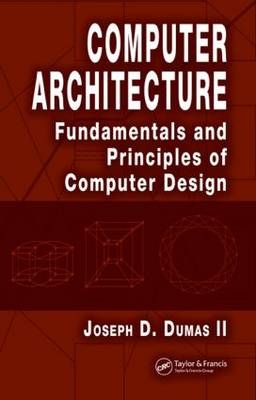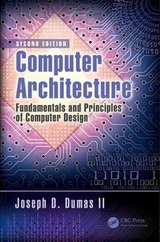
Computer Architecture
Crc Press Inc (Verlag)
978-0-8493-2749-0 (ISBN)
- Titel erscheint in neuer Auflage
- Artikel merken
Future computing professionals must become familiar with historical computer architectures because many of the same or similar techniques are still being used and may persist well into the future. Computer Architecture: Fundamentals and Principles of Computer Design discusses the fundamental principles of computer design and performance enhancement that have proven effective and demonstrates how current trends in architecture and implementation rely on these principles while expanding upon them or applying them in new ways.
Rather than focusing on a particular type of machine, this textbook explains concepts and techniques via examples drawn from various architectures and implementations. When necessary, the author creates simplified examples that clearly explain architectural and implementation features used across many computing platforms.
Following an introduction that discusses the difference between architecture and implementation and how they relate, the next four chapters cover the architecture of traditional, single-processor systems that are still, after 60 years, the most widely used computing machines. The final two chapters explore approaches to adopt when single-processor systems do not reach desired levels of performance or are not suited for intended applications. Topics include parallel systems, major classifications of architectures, and characteristics of unconventional systems of the past, present, and future.
This textbook provides students with a thorough grounding in what constitutes high performance and how to measure it, as well as a full familiarity in the fundamentals needed to make systems perform better. This knowledge enables them to understand and evaluate the many new systems they will encounter throughout their professional careers.
Introduction to Computer Architecture
What is Computer Architecture?
Architecture vs. Implementation
Brief History of Computer Systems
The First Generation
The Second Generation
The Third Generation
The Fourth Generation
Modern Computers - The Fifth Generation
Types of Computer Systems
Single Processor Systems
Parallel Processing Systems
Special Architectures
Quality of Computer Systems
Generality and Applicability
Ease of Use
Expandability
Compatibility
Reliability
Success and Failure of Computer Architectures
and Implementations
Quality and the Perception of Quality
Cost Issues
Architectural Openness, Market Timing and Other Issues
Measures of Performance
CPU Performance
Memory System Performance
I/O System Performance
System Benchmarks
Chapter Wrap-Up
Review Questions
Computer Memory Systems
The Memory Hierarchy
Characteristics of an Ideal Memory
Characteristics of Real Memory Devices
Hierarchical Memory Systems
Main Memory Interleaving
High-Order Interleaving
Low-Order Interleaving
Logical Organization of Computer Memory
Random Access Memories
Sequential Access Memories
Associative Memories
Cache Memory
Locality of Reference
Hits, Misses, and Performance
Mapping Strategies
Cache Write Policies
Cache Replacement Strategies
Cache Initialization
Memory Management and Virtual Memory
Why Virtual Memory?
Virtual Memory Basics
Paged Virtual Memory
Segmented Virtual Memory
Segmentation with Paging
The MMU and TLB
Cache and Virtual Memory
Chapter Wrap-Up
Review Questions
Basics of the Central Processing Unit
The Instruction Set
Machine Language Instructions
Functional Categories of Instructions
Instruction Addressing Modes
Number of Operands Per Instruction
Memory-Register vs. Load-Store Architectures
CISC and RISC Instruction Sets
The Datapath
The Register Set
Integer Arithmetic Hardware
Arithmetic with Real Numbers
The Control Unit
A Simple Example Machine
Hardwired Control Unit
Microprogrammed Control Unit
Chapter Wrap-Up
Review Questions
Enhancing CPU Performance
Pipelining
Arithmetic Pipelines
Types of Arithmetic Pipelines
Pipeline Scheduling and Control
Instruction Unit Pipelines
Basics of an Instruction Pipeline
Control Transfers and the Branch Penalty
Branch Prediction
Delayed Control Transfers
Memory Accesses - Delayed Loads and Stores
Data Dependencies and Hazards
Controlling Instruction Pipelines
Characteristics of RISC Machines
Enhancing the Pipelined CPU
Superpipelined Architectures
Superscalar Architectures
Very Long Instruction Word (VLIW) Architectures
Chapter Wrap-Up
Review Questions
Exceptions, Interrupts, and Input/Output Systems
Exceptions
Hardware-Related Exceptions
Software-Related Exceptions
Input and Output Device Interfaces
Program-Controlled I/O
Memory-Mapped I/O
Separate I/O
Interrupt-Driven I/O
Direct Memory Access
Input/Output Processors
Chapter Wrap-Up
Review Questions
Parallel and High-Performance Systems
Types of Computer Systems - Flynn's Taxonomy
Vector Processors
Array Processors
Multiprocessor Systems
Multicomputer Systems
Interconnection Networks for Parallel Systems
Purposes of Interconnection Networks
Interconnection Network Terms and Concepts
Static Interconnection Networks
Buses
Linear and Ring Topologies
Star Network
Tree and Fat Tree Networks
Nearest-Neighbor Mesh
Torus and Illiac Networks
Hypercube Networks
Routing in Static Networks
Dynamic Interconnection Networks
Crossbar Switch
Recirculating Networks
Multistage Networks
Chapter Wrap-Up
Review Questions
Special-Purpose and Future Architectures
Dataflow Machines
Artificial Neural Networks
Fuzzy Logic Architectures
Quantum Computing
Chapter Wrap-Up
Review Questions
Appendix: Reference and Further Reading Materials with Web Links
| Erscheint lt. Verlag | 2.11.2005 |
|---|---|
| Zusatzinfo | 7 equations; 18 Tables, black and white; 175 Illustrations, black and white |
| Verlagsort | Bosa Roca |
| Sprache | englisch |
| Maße | 152 x 229 mm |
| Gewicht | 703 g |
| Themenwelt | Mathematik / Informatik ► Informatik ► Theorie / Studium |
| ISBN-10 | 0-8493-2749-0 / 0849327490 |
| ISBN-13 | 978-0-8493-2749-0 / 9780849327490 |
| Zustand | Neuware |
| Haben Sie eine Frage zum Produkt? |
aus dem Bereich



